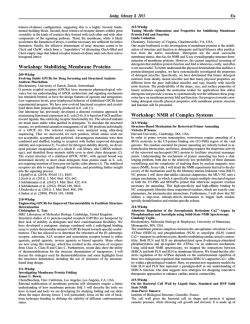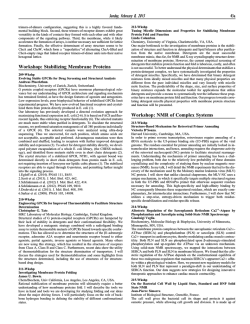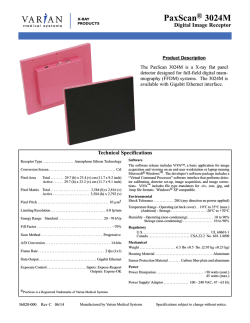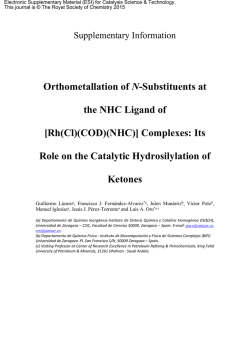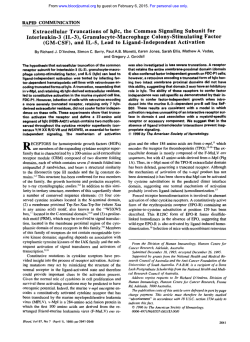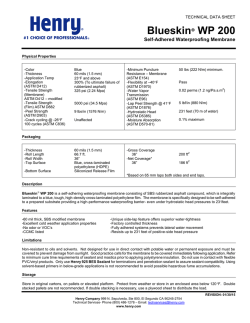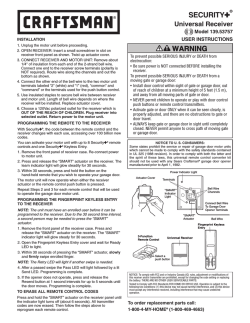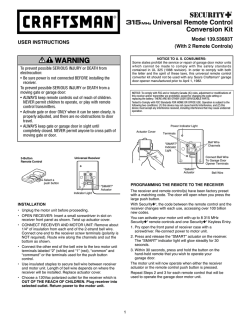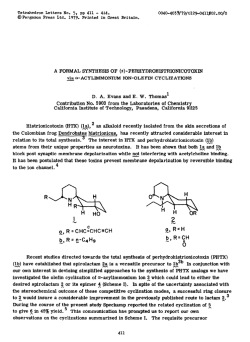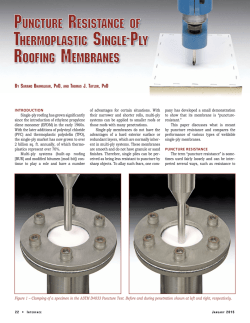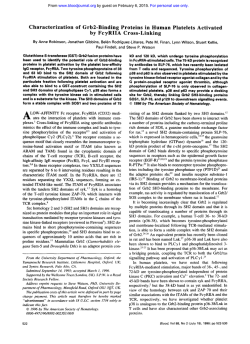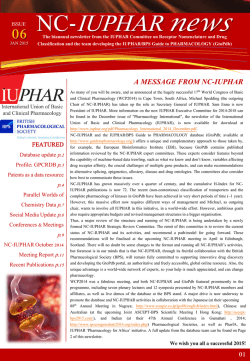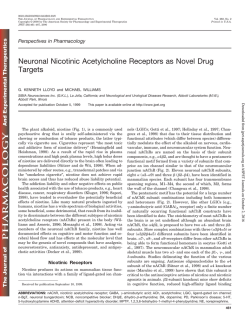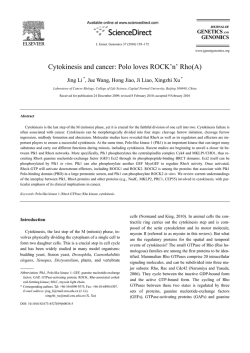
Architecture and Assembly of Chemoreceptor Arrays as seen
42a Sunday, February 8, 2015 CheA and CheW, peptides exhibit protection from exchange at long times (16 hours) that is greater in the kinase-on state. HDX-MS of complexes prepared using different means of shifting the signaling state will reveal which changes correlate with kinase activity and will quantify stabilization of receptor subdomains and binding interfaces that contribute to receptor control of kinase activity. Thus HDX-MS provides an important tool in a hybrid approach for understanding structure and mechanism in membrane-bound, multi-protein complexes. This research supported by GM085288, and a University of Massachusetts fellowship to Seena Koshy as part of the Chemistry-Biology Interface Training Program (NRSA T32 GM08515). 203-Plat Disulfide Trapping and Spectroscopic Studies of Bacterial Chemosensory Core Signaling Complexes: Probing Molecular Mechanisms of Complex Assembly and Receptor-Regulated On-Off Switching Joseph J. Falke, Kene N. Piasta, Marie Balboa, Jane Duplantis, Hayden Swisher, Michael Turvey. Department of Chemistry & Biochemistry, Univ Colorado, Boulder, CO, USA. The core unit of the bacterial chemosensory array is multi-protein complex comprised of 6 transmembrane chemoreceptor homodimers, 1 CheA His kinase homodimer, and 2 CheW adaptor protein monomers. We are reconstituting core units on isolated bacterial membranes, yielding individual core units and oligomers of core units ranging in size up to small hexagonal arrays. This approach generates functional, membrane-bound core complexes and allows incorporation of modified kinase and adaptor proteins possessing pairs of engineered Cys residues for disulfide trapping, or spectroscopic probes for fluorescence or EPR studies. The resulting core complexes display native receptor-stimulated kinase activities that are fully regulated by attractant binding to the receptor, or covalent modification of the receptor adaptation sites. The findings shed new light on the kinetics and order of core complex assembly, and provide insights into the molecular mechanisms underlying receptormediated kinase on-off switching. 204-Plat Flagellar Motor Architecture Frederick W. Dahlquist. Chemistry and Biochemistry, UC Santa Barbara, Santa Barbara, CA, USA. The cytoplasmic or C-ring of the bacterial flagellar motor plays central roles in transmitting torque from peptido-glycan anchored membrane protein complexes MotA and MotB and in controlling the sense of rotation of the motor. The C-ring is made up of three proteins, FliN, FliM and FliG with differing copy numbers. The C-ring is attached to the MS-ring via interactions between FliF and the N-terminal domain of FliG. We have used a combination of NMR, x-ray diffraction and mutant analysis to investigate the structures of the domains of FliG and of the N-terminal domain of FliG with FliF. These results will be discussed in the context of various models that have been proposed to account for the assembled structure of the C-ring and the mechanism of torque transmission and the control of the sense of rotation of the flagellar motor. 205-Plat Structure and Dynamics of the Receptor:Kinase Complex that Mediates Bacterial Chemotaxis Brian R. Crane. Chemsitry and Chemical Biology, Cornell University, Ithaca, NY, USA. Bacterial chemotaxis, the ability of bacteria to adapt their motion to external stimuli, has long stood as a model system for understanding transmembrane signaling, intracellular information transfer, and motility. The sensory apparatus underlying chemotaxis displays remarkably sensitivity, robustness, and dynamic range. These properties stem from a highly cooperative excitation response and an integral feedback mechanism for adaptation to changing surroundings. Although the molecular components of the chemotaxis system are well characterized, we still do not fully understand the biophysical mechanisms responsible for function. This is because the sensory apparatus comprises an extensive multi-component transmembrane assembly of chemoreceptors, histidine kinases (CheA) and coupling proteins (CheW), whose architecture is just emerging. We will discuss efforts to understand the detailed structure of the chemoreceptor:CheA:CheW complex and how chemoreceptors transmit signals across the membrane to regulate CheA activity. To address these issues, studies have been undertaken on isolated components, reconstituted complexes, and native receptor arrays. Soluble, chemoreceptor maquettes that mimic receptor oligomeric states have been particularly useful for studying kinase activation. Evidence will be presented to support the notion that changes to both molecular structure and dynamics are involved in signal transduction by the receptor:kinase assemblies. 206-Plat HAMP: The CPU Domain of Bacterial Chemoreceptors John Parkinson. Biology, Univ Utah, Salt Lake City, UT, USA. The transmembrane chemoreceptors that mediate chemotactic behaviors in E. coli contain a HAMP domain at the cytoplasmic face of the membrane that governs their input-output signaling transactions. The four-helix HAMP bundle receives stimulus signals from the periplasmic chemoeffector-binding domain via a five-residue control cable connection to a transmembrane helix (TM2). HAMP in turn, through its structural interactions with an adjoining four-helix methylation (MH) bundle, modulates the activity of CheA, a cytoplasmic histidine autokinase bound at the membrane-distal tip of the receptor molecule. To investigate the mechanism of HAMP signaling in Tsr, the E. coli serine chemoreceptor, my lab has characterized the serine sensitivities and response cooperativities of a large collection of mutant receptors that have amino acid replacements in the TM2 - control cable - HAMP - MH bundle region, using an in vivo FRET-based assay of CheA kinase activity. Signaling by wild-type Tsr follows a two-state model of shifts between kinase-activating and kinase-deactivating outputs. Both states correspond to ensembles of mutationally distinct HAMP conformations. A variety of HAMP structural lesions, including ablation of the entire domain, shift receptor output toward the kinase-on state, indicating that the signaling role of HAMP is not to activate CheA, but rather to down-regulate kinase activity in response to chemoattractant ligands. Stimulus signals from TM2 and the control cable probably trigger output responses by modulating the packing stability of HAMP: A loosely packed HAMP bundle allows kinase activity; a tightly packed HAMP bundle deactivates CheA. These signaling shifts occur through an opposing structural interplay of packing stability in the HAMP and MH bundles. Loosely packed methylation helices produce kinase-off output and serve as substrates for subsequent receptor modifications that enhance MH packing during the sensory adaptation phase of an attractant response. 207-Plat Signal Integration by Bacterial Chemosensory Complexes Victor Sourjik. Systems and Synthetic Microbiology, Max Planck Institute for terrestrial Microbiology, Marburg, Germany. Chemotaxis receptors in bacteria are organized in large clusters that play an essential role in signal processing. Allosteric interactions within these clusters allow activities of individual receptors to be coupled. The resulting cooperative signaling is well investigated and can be mathematically described using Monod-Wyman-Changeux (MWC) or Ising models, but its importance in the overall signal processing by the chemotaxis pathway is not fully understood. One established function of the cooperative signaling is to amplify chemotactic stimuli, whereby ligand binding to one receptor molecule can stabilize inactive state of multiple neighboring receptors. Using FRET-based reporter of the pathway activity, we have recently investigated another function of the allosteric interactions between receptors, namely in integration and coordination of responses to multiple stimuli sensed by different receptors. We showed that such signal integration could be explained by a simple summation of free energy changes that are elicited by individual ligands. Moreover, receptor clusters also integrate metabolism-related signals that are transmitted through the cytoplasmic domains of the receptors. Finally, receptor clustering also allows cells to align adaptation kinetics for different attractants, ensuring a robust and optimal time scale of the short-term memory that is required for efficient navigation in chemoeffector gradients. 208-Plat Architecture and Assembly of Chemoreceptor Arrays as seen by Electron Cryotomography Ariane Briegel. Biology and Biological Engineering, California Institute of Technology, Pasadena, CA, USA. Most motile bacteria as well as many archaea sense and respond to their environment through arrays of chemoreceptors. While X-ray crystallography and NMR spectroscopy and other high-resolution structural methods have produced atomic models of components and sub-complexes of these arrays, we have used electron cryotomography to visualize their basic architecture in their native state within intact cells and reconstituted in vitro systems to ~2 nm resolution, revealing principles of array structure and assembly. First, receptors cluster in a Sunday, February 8, 2015 trimers-of-dimers configuration, suggesting this is a highly favored fundamental building block. Second, these trimers-of-receptor dimers exhibit great versatility in the kinds of contacts they formed with each other and with other components of the signaling pathway. Third, the membrane, while it likely accelerates the formation of arrays, is neither necessary nor sufficient for lattice formation. Finally, the effective determinant of array structure seems to be CheA and CheW, which form a ‘‘superlattice’’of alternating CheA-filled and CheA-empty rings that linked receptor trimers-of-dimer units into their native hexagonal lattice. Workshop: Stabilizing Membrane Proteins 209-Wkshp Evolving Stable GPCRs for Drug Screening and Structural Analysis Andreas Plueckthun. Biochemistry, University of Zurich, Zurich, Switzerland. G protein coupled receptors (GPCRs) have enormous pharmacological relevance but our understanding of GPCR architecture and signaling mechanism has remained limited, as have the design features of agonists and antagonists. Low expression levels, poor biophysical behavior of solubilized GPCRs limit experimental progress. We have now evolved functional receptors and crystallized them from protein directly produced in E. coli (1). Our laboratory has previously developed a directed evolution approach for maximizing functional expression in E. coli (2-6). It is based on FACS and fluorescent ligands, thus enforcing receptor functionality (6). The selected mutants are much more stable when purified in detergents. To elucidate the structural reasons, we performed saturation mutagenesis of all 380 positions individually of a GPCR (4). The selected variants were analyzed using ultra-deep sequencing. Thus we uncovered, for each position, which amino acids are not acceptable, acceptable and preferred. Advantageous mutations were then combined and shuffled, leading to receptors with further improved detergent stability and expression (3). To select for detergent stability directly, we developed polymer encapsulation of a whole E. coli library, (the CHESS technology), and identified those mutants stable even in short chain detergents (2). The crystal structure of a stabilized GPCR, NTR1, with agonist bound was determined directly in short chain detergents from protein made in E. coli, not requiring insertion of lysozyme nor lipidic cubic phases (1). The stabilized receptors are able to signal through G-proteins, and permitting further insight into the signaling process. 1.Egloff et al. (2014). PNAS 111, E655. 2.Scott et al. (2013). J. Mol. Biol. 425, 662. 3.Schlinkmann et al. (2012) J. Mol. Biol. 422, 414. 4.Schlinkmann et al. (2012). PNAS 109, 9810. 5.Dodevski et al. (2011). J. Mol. Biol. 408, 599. 6.Sarkar et al. (2008). PNAS 105, 14808. 210-Wkshp Engineering GPCRs for Improved Thermostability to Facilitate Structure Determination Christopher G. Tate. MRC Laboratory of Molecular Biology, Cambridge, United Kingdom. Structural studies of G protein-coupled receptors (GPCRs) are hampered by their lack of stability in detergents and their conformational flexibility. We have developed a mutagenic strategy combined with a radioligand binding assay to isolate thermostable mutants of GPCRs biased towards specific conformations. This has allowed us to determine the structures of the b1-adrenergic receptor, adenosine A2A receptor and neurotensin receptor bound to either agonists, partial agonists, inverse agonists or biased agonists. Many others are now using this strategy, which has resulted in the structures of receptors from Class A, Class B and Class C. Furthermore, recent data show the utility of thermostabilisation for the structure dtermination of transporters. I will discuss the strategies used for thermostabilisation and some highlights from the structures determined, including the use of structures of for structurebased drug design. 211-Wkshp Investigating Membrane Protein Folding James U. Bowie. Chem/Biochem, Univ California, Los Angeles, Los Angeles, CA, USA. Rational stabilization of membrane proteins will ultimately require a better understanding of how membrane proteins fold. I will describe the tools we have in hand and tools we are developing for studying folding and our ideas about the major driving forces. I will particularly focus on the role of backbone hydrogen bonding in defining the stability of different conformational states. 43a 212-Wkshp Tuning Micelle Dimensions and Properties for Stabilizing Membrane Protein Fold and Function Linda Columbus. Chemistry, University of Virginia, Charlottesivlle, VA, USA. One major bottleneck to the investigation of membrane proteins is the stabilization of structure and function in detergents and lipid bilayers after purification from the native membrane. Detergents are the most successful membrane mimic, thus far, for NMR and X-ray crystallography structure determination of membrane proteins. However, the current empirical screening of detergents that stabilize protein function and fold is laborious, costly, and often is not successful. To better understand the physical determinants that stabilize a protein-detergent complex, we have systematically investigated the properties of detergent micelles. Specifically, we have determined that binary detergent mixtures form ideally mixed micelles and that many physical properties are different from the pure individual micelles and vary linearly with micelle mole fraction. The predictability of the shape, size, and surface properties of binary mixtures expands the molecular toolkit for applications that utilize detergents and provide a means to systematically test the influence these properties have on membrane protein fold and function. Our progress towards correlating detergent micelle physical properties with membrane protein structure and function will be presented. Workshop: NMR of Complex Systems 213-Wkshp Structure-Based Mechanism for Retroviral Primer Annealing Victoria D’Souza. Harvard University, Cambridge, MA, USA. In order to prime reverse transcription, retroviruses require annealing of a tRNA molecule to the U5-primer binding site (U5-PBS) region of the viral genome. The residues essential for primer annealing are initially locked in intramolecular interactions, and hence, annealing requires the chaperone activity of the retroviral nucleocapsid (NC) protein to facilitate structural rearrangements. Understanding the mechanism of primer annealing has been a challenging problem, both due to the relatively low probability of these domains crystallizing and the complexity of studying them by nuclear magnetic resonance (NMR). In my talk, I will detail the NMR experiments that led to the discovery of the mechanism used by the Moloney murine leukemia virus (MLV) NC protein. I will show that unlike classical chaperones, the MLV-NC uses a unique mechanism, in which it specifically targets multiple structured regions in both the U5-PBS and tRNAPro primer that otherwise sequester residues necessary for annealing. This high-specificity and high-affinity binding by NC consequently liberates these sequestered residues_which are exactly complementary_for intermolecular interactions. Furthermore, I will show that NC utilizes a step-wise, entropy-driven mechanism to trigger both residuespecific destabilization and residue-specific release. 214-Wkshp Allosteric Regulation of the Sarcoplasmic Reticulum Ca2D-Atpase by Phospholamban and Sarcolipin using Solid-State NMR Spectroscopy Gianluigi Veglia. Biochemistry, Molecular Biology & Biophysics, University of Minnesota, Minneapolis, MN, USA. The membrane protein complexes between the sarcoplasmic reticulum Ca2þATPase (SERCA) and phospholamban (PLN) or sarcolipin (SLN) control Ca2þ transport in cardiomyocytes, thereby modulating cardiac muscle contractility. Both PLN and SLN are phosphorylated upon b-adrenergic-stimulated phosphorylation and up-regulate the ATPase via an unknown mechanism. Using solid-state NMR spectroscopy, we mapped the interactions between SERCA and both PLN and SLN in membrane bilayers. We found that the allosteric regulation of the ATPase depends on the conformational equilibria of these two endogenous regulators that maintain SERCA’s apparent Ca2þ affinity within a physiological window. Here, we present new regulatory models for both SLN and PLN that represent a paradigm-shift in our understanding of SERCA function. Our data suggests new strategies for designing innovative therapeutic approaches to enhance cardiac muscle contractility. 215-Wkshp On the Bacterial Cell Wall by Liquid State, Standard and DNP Solid State NMR Jean-Pierre Simorre. Institute of Biological Structure, Grenoble, France. The cell wall gives the bacterial cell its shape and protects it against osmotic pressure, while allowing cell growth and division. It is made up of
© Copyright 2025
